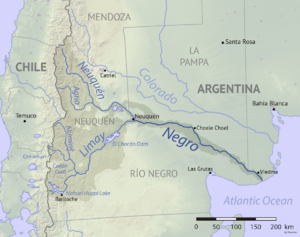Limay River facts for kids
Quick facts for kids Limay River |
|
|---|---|

Aerial view of the Limay River looking southeast
|
|
| Country | Argentina |
| Physical characteristics | |
| Main source | Nahuel Huapi Lake 770 m (2,530 ft) AMSL |
| River mouth | into Río Negro 38°59′35″S 68°00′18″W / 38.993°S 68.005°W |
| Length | 380 km (240 mi) |
| Basin features | |
| Basin size | 61,723 km2 (23,831 sq mi) |
The Limay River is a very important river in the northwestern part of Argentina, in a region called Patagonia. It begins at the eastern end of Nahuel Huapi Lake. The river then flows in a winding path for about 380 kilometers (236 miles).
As it travels, the Limay River collects water from several smaller rivers. These include the Traful River, the Pichileufú, and the Collón Curá. Eventually, the Limay River meets the Neuquén River. When these two rivers join, they form the Río Negro. The city of Neuquén is located right where the Limay and Neuquén rivers meet.
Contents
Where the Limay River Flows
The Limay River acts as a natural border between two provinces: Río Negro and Neuquén. Its waters are deep and clear. The river carries a large amount of water, about 700 cubic meters (24,720 cubic feet) per second on average.
The area that drains into the Limay River is huge, covering about 61,723 square kilometers (23,831 square miles). This area includes almost all the rivers and streams that flow towards the Atlantic Ocean in this region. It also has a large network of lakes that feed into the river.
The name "Limay" comes from the Mapuche people. It means "crystalline," which describes how clear you can see to the bottom of the river.
Power from the River
The waters of the Limay River are used to create hydroelectricity. This is a way to make electricity using the power of moving water. There are five dams built along the river's course. These dams are:
- Alicurá
- Piedra del Águila
- Pichi Picún Leufú
- El Chocón
- Arroyito
These dams, along with the Cerros Colorados Complex on the Neuquén River, produce a lot of electricity. Together, they create more than one-quarter of all the hydroelectric power in Argentina! Because these dams and reservoirs were built, the river's length has become shorter. It used to be about 450 kilometers (280 miles) long.
Fun Activities on the Limay
The Limay River is a popular spot for fly fishing. This is a special way of fishing using artificial flies as bait. In some places, the river banks are perfect for beach resorts. These spots often have facilities for camping, so people can stay and enjoy the beautiful natural surroundings.
Some islands in the lower part of the river, which are usually flooded, have been developed into urban areas.
Gallery
See also
 In Spanish: Río Limay para niños
In Spanish: Río Limay para niños






